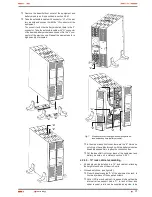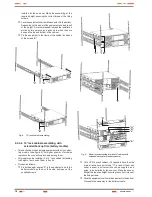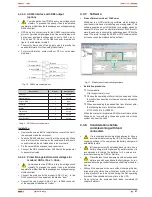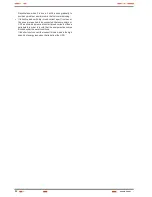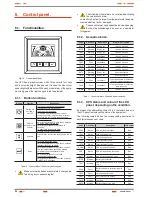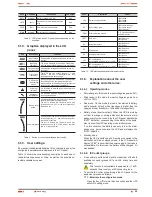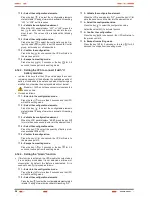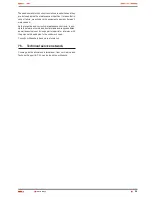
14
4. Installation.
•
Check the Safety instructions, from section 1.2.3.
•
Check that the data in the nameplate are the required by the
installation.
•
A wrong connection or manoeuvring, can make faults in the
UPS and/or loads connected to itself. Read carefully the in-
structions of this manual and follow the stated steps in the
established order.
•
The equipments can be installed and used by per-
sonnel with no specific training just with the help of this
«Manual».
•
All connections of the equipment including the control
(interface, remote panel, ...), will be done with the
switches at rest and no voltage present (UPS power supply
switch to «Off»).
•
Never forget that the UPS is an electrical energy gen-
erator, so the user has to take the needed cautions
against direct and indirect contacts.
•
Under request, we are able to supply a manual bypass panel.
•
Battery circuit is not isolated from input voltage. Haz-
ardous voltages can be found out between the battery
terminals and earth. Check that there is not input voltage be-
fore doing any intervention on them.
4.1. To be considered in the
installation.
•
All the range has a power cord with plug for input and IEC
outlets for output, as connection parts for power. The rest of
connections are done through the connectors, including the
connection of the equipment with the battery module (it is not
available on equipments below 1000VA).
•
Cross cable section of the bypass, input and output lines,
will be calculated from the currents stated in the nameplate
of each equipment, and respecting the Local and/or National
Low Voltage Electrotechnical Regulations.
•
Protections of the switchgear panel, will have the following
features:
For input line, type B for RCD devices and C character-
istic for circuit breakers.
For the output (load feeding), C characteristic for circuit
breaker.
Regarding the size, they will be as minimum to the currents
stated in the nameplate of each UPS.
•
In the nameplate of the equipment there are only printed the
nominal currents as it is stated in the safety standard EN-IEC
62040-1. To calculate the input current, the power factor and
the efficiency of the equipment have been considered.
Overload conditions are considered as nonpermanent and
exceptional operating mode.
•
If it is added peripherals to the input and/or output like trans-
formers or autotransformers to the UPS, the currents stated in
the own nameplates of those elements has to be considered
in order to use the suitable cross sections, by respecting the
Local and/or National Low Voltage Regulation.
•
When an equipment incorporates a galvanic isolation
transformer, as standard, as an option or either in-
stalled by yourself, either at the UPS input or output or at all
of them, protections against indirect contact has to be fitted in
(residual current device) at the output of each transformer,
because due to its specification of isolation it will prevent the
triggering of the protections fitted in the primary of the trans-
former in case of electrical shock in the secondary (output of
the isolation transformer).
•
Remind you that all external isolation transformers already
installed or supplied from factory, has the neutral of the sec-
ondary connected to earth by means of a cable bridge be-
tween both terminals. If it were required an isolated output
neutral, remove this cable bridge, keeping the precautions
stated in the respective local and/or national low voltage reg-
ulations.
•
All the UPSs have batteries inside the same rack enclosure
of the equipment. Battery protection is by means of fuse and
internal, so it is no accessible by the end-user.
Battery modules have internal protections by fuse, and they
are not accessible by the end-user too.
4.2. Reception of the equipment.
4.2.1. Unpacking, content checking and
inspection.
•
To unpack, see section 4.2.3.
•
On receiving the device, make sure that it has not suffered
any damage in transport (impact, drop, ...) and its features
correspond with the ones in the order, so it is recommended
to unpack the UPS and make a first visual inspection.
•
In case of observing damages, make all pertinent claims to
the transport agency or in their lack to our company.
Never start up an equipment when external damages
can be observed.
•
Also check that the data in the nameplate sticked in the pack-
aging and in the equipment, correspond to the ones stated
in the order, so it is required to unpack it (see section 4.2.3).
Otherwise, make a nonconformity as soon as possible, by
quoting the serial number of the equipment and references
in the delivery note.
•
Check the contents of the packaging. Depending, if we are
checking an equipment or battery module, the contents will
vary.
Equipment:
–
The own equipment.
–
Quick guide in paper.
–
1 power cord for input connection -schuko plug and
IEC connector-.
–
2 cables for output connection with IEC connectors.
–
1 communication cable USB.
–
4 plastic pieces to be joint two by two to fit the UPS
in vertical position.
–
Two metallic pieces with L shape to adapt the equip-
ment to rack format.
Battery module:
–
The own equipment.
–
1 connection cable for protection earth, to link the
equipment and module.
–
2 plastic pieces to adapt the supports of vertical in-
stallation of the UPS and batteries (battery modules
for equipments up to 3 kVA only).
–
1 metallic piece and bolt to joint the battery module
with the equipment on tower format.
USER MANUAL

















